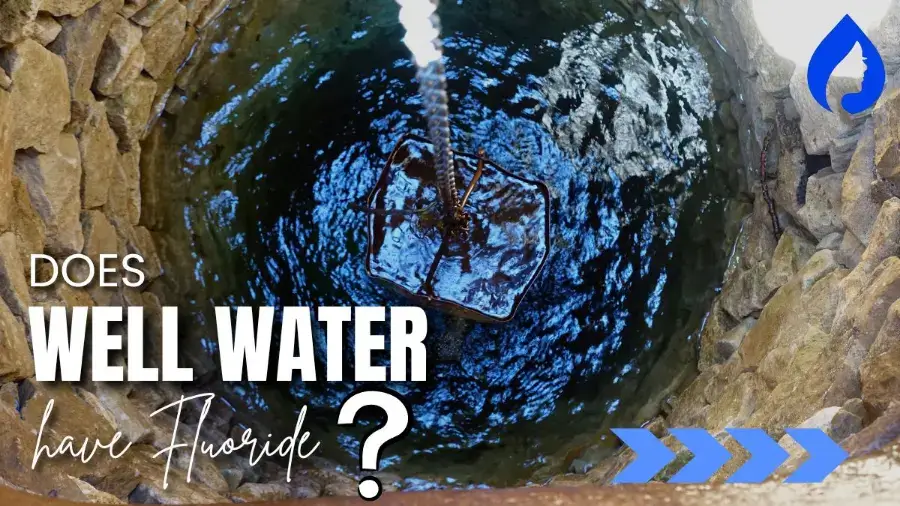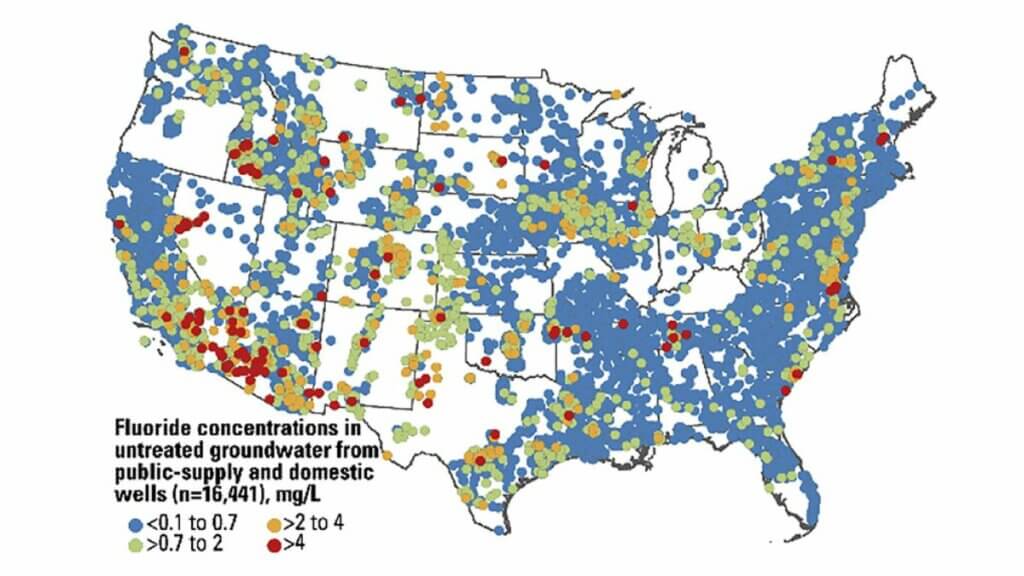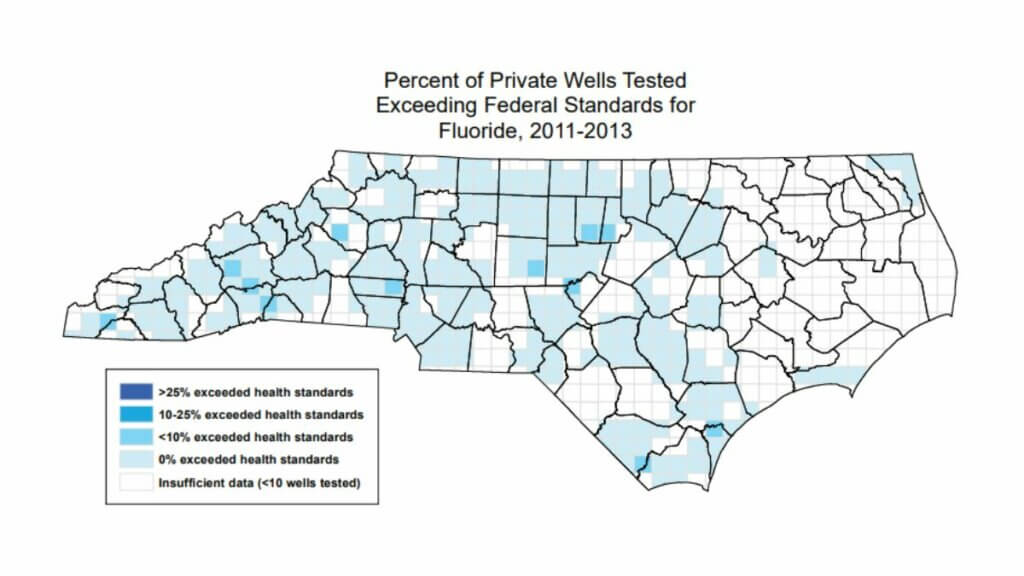
Yes, you’ll naturally find fluoride in well water as it’s a common element in the earth’s crust.
According to a 2020 study on 38,105 US wells, 87% of wells have safe fluoride concentrations of less than 0.7 mg/L.
10.9% of wells have more than 0.7 mg/L, which is more than the recommended safe limit proposed by HHS.
0.6% of wells have an alarming fluoride concentration of more than 4 mg/L as recognized by EPA standards.
Continue reading for an in-depth explainer on fluoride concentrations in well water and 3 simple ways to remove excess fluoride.
🤔How Much Fluoride Is in Well Water?

Fluoride enters groundwater through two main channels: industrial activities and erosion.
In a comprehensive study conducted in 2020 by the U.S. Geological Survey (USGS) and utilizing data from the National Water Information System (NWIS) database, approximately 38,105 wells across the United States were analyzed for their fluoride content.
The results highlighted the following distribution of fluoride concentrations:
| % of wells tested | Fluoride in well water |
| 87% | Below 0.7 mg/L [Safe] |
| 10.9% | 0.7-2 mg/L [Troublesome] |
| 2.6% | 2-4 mg/L [Concerning] |
| 0.6% | 4+ mg/L [Potentially Dangerous] |
💡Note:
1. Below 0.7 mg/L: Safe limit as per HHS to prevent tooth decay and reduce the chances of dental fluorosis.
2. More than 4 mg/L: Exceeds EPA’s enforceable drinking water standard to prevent cases of skeletal fluorosis.
As you can see from the map above, the eastern USA is mostly safe from concerning fluoride concentrations. 75% of principal aquifers that exceeded HHS and EPA limits belonged to the western USA.
The maximum fluoride concentration in public supply domestic wells is found in Illinois (15.5 mg/L) and Idaho (16 mg/L). California aquifers had the highest natural fluoride concentrations of 160 mg/L.
In the eastern USA, the places with the highest or too much fluoride concentrations include:
Before 2020, a study was conducted in North Carolina (NC) in 2013, where at least 10% of wells exceeded HHS health standards, as you can see from the map below:

However less than 1% of NC wells exceeded the EPA health standard of 4 mg/L.
⬆️What Is the Maximum Acceptable Limit of Fluoride?
The acceptable limits of fluoride levels in drinking water vary among different organizations. Some of these limits include:
When present in less than 0.7 mg/L concentrations, fluoride can have a lot of health benefits:
The benefits of fluoride are mostly topical, so it’s best to obtain them via toothpaste and dental products.
Risks of excess fluoride concentrations (more than 4 mg/L) in drinking water include:
Note:
You can’t taste or smell fluoride levels in water. So, it’s best to have the water tested in a certified laboratory to confirm excess concentrations.
Also Read: Do Deeper Wells Mean Better Water?
🎯How to Remove Fluoride from Well Water

First things first: Boiling water doesn’t eliminate fluoride; in fact, it can increase its concentration.
Here are the 3 simple methods to remove fluoride from well water:
💦Reverse Osmosis Filters
Reverse osmosis, achieved by pressurizing water through a semipermeable membrane, effectively eliminates naturally occurring fluoride and other contaminants.
These systems are easily installed under sinks or as whole-house solutions, ensuring reliable and fluoride-free water purification. They offer reliable purification, leaving you with fluoride-free water.
🍶Distillers
Another powerful technique is distillation. This method involves the application of heat to water, causing it to turn into steam, which is then condensed back into its liquid state.
Through this process, most impurities, including fluoride, are left behind.
Although distillation consumes a significant amount of energy, it remains a trustworthy and effective means of removing fluoride from water.
Also Read: Can Dogs Drink Well Water?
⚫Bone Charcoal Carbon Filters
Activated bone charcoal filters effectively adsorb fluoride.
These filters contain bone char, which is a form of carbon that has been treated to enhance its adsorption properties.
As water passes through the filter, fluoride ions are attracted to the bone char, reducing fluoride levels.
Also Read: Does Zerowater Remove Fluoride?
💡Does Well Water Have Fluoride FAQs
Does well water have chlorine and fluoride?
Well water doesn’t naturally contain chlorine unless you perform shock chlorination. Fluoride is naturally present in groundwater, but around 87% of US wells have safer concentrations below 0.7 mg/L.
How does fluoride get into well water?
Fluoride can enter well water:
1. Naturally, through the erosion of rocks
2. Artificially through discharge from industrial activities.
How to test well water for fluoride?
You can test well water for too much fluoride in drinking water by submitting water samples to a certified lab, as the ionic compound has no taste or smell.
You can also opt for a fluoride water test from tapscore to find detailed water reports within 5 days.
Does well water contain lead?
Lead isn’t detected in groundwater but can enter the well water supply through man-made activities coal and gasoline mining.
However, the major lead source in private well water continues to be lead pipes and fixtures commonly found in homes built before the 1970s.
Does bottled water have fluoride?
Bottled water may contain fluoride, depending on the source water for bottling. Some manufacturers add fluoride to promote oral health, like municipal water supply.
Most bottled water brands contain safe fluoride limits, but you can always double-check the manufacturer’s label to be sure.
Adarsh is a Health & Nutrition Sciences graduate with expertise in environmental health. He is associated with ventures like Glacier Fresh Filter and Simpure Filter Systems. Through Aqua Professor, he intends to provide helpful information to every home to help them make smarter decisions.
